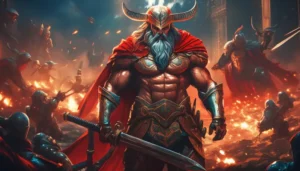Descend into Darkness: Unraveling the Mysteries of Hades
Hades: Prepare to embark on a journey into the depths of the underworld, the domain of Hades, the enigmatic Greek god of the dead. Often shrouded in shadows and misconceptions, Hades is a figure of immense power and complexity, ruling over a realm that holds both fear and fascination for mortals.
Born from the Titan’s Reign: Hades’ Lineage and Rise to Power
In the dawn of time, before the reign of the Olympians, the Titans ruled over the cosmos. Cronus, the king of the Titans, and his wife Rhea bore several children, including the mighty Zeus, Poseidon, and Hades. Fearful of a prophecy foretelling his own demise, Cronus devoured his children as soon as they were born.
However, Rhea, heartbroken and desperate, managed to save her youngest son, Zeus. As Zeus grew older, he sought to free his siblings from their father’s cruel fate. After a fierce battle, known as the Titanomachy, the Olympian gods triumphed, overthrowing the Titans and establishing a new order.
Dividing the Cosmos: Hades’ Claim to the Underworld
In the aftermath of the Titanomachy, the three brothers, Zeus, Poseidon, and Hades, drew lots to determine their domains. Zeus became the ruler of the sky, Poseidon the lord of the sea, and Hades, to his dismay, was assigned the underworld.
Lord of the Dead: Hades’ Role and Responsibilities
As the god of the underworld, his primary responsibility was to rule over the souls of the departed. He presided over the judgment of the dead, determining their fate in the afterlife. He ensured the souls of the wicked were punished for their transgressions and those who lived virtuous lives were rewarded.
The Underworld’s Grim Landscape: A Glimpse into Hades’ Domain
Hades’ realm was a vast and mysterious place, often depicted as a dark and desolate landscape. The entrance to the underworld was guarded by Cerberus, a fearsome three-headed dog. The rivers Styx and Acheron flowed through the underworld, marking the boundary between the world of the living and the realm of the dead.
Hades’ Consort: The Abduction of Persephone
One of the most famous myths associated with him is the abduction of Persephone, the daughter of Demeter, the goddess of agriculture. Hades, smitten with Persephone’s beauty, abducted her to the underworld, plunging the world into a season of darkness and despair. Demeter’s grief was so profound that it caused the crops to wither and die.
Eventually, a compromise was reached, allowing Persephone to spend part of the year with her mother in the world above and the rest with Hades in the underworld. This myth explains the changing seasons, as Persephone’s return to the surface brings forth the spring and summer, while her descent to the underworld marks the arrival of autumn and winter.
Symbols of Power and Dread: The Bident and Cerberus
He is often depicted with a bident, a two-pronged spear, symbolizing his authority over the underworld. This powerful weapon is said to have the ability to cleave the earth open, creating pathways to the realm of the dead. Another prominent symbol associated with Hades is Cerberus, the monstrous three-headed dog who guards the entrance to the underworld, ensuring that no living soul enters and no dead soul escapes.
The Helm of Darkness: A Gift of Invisibility
In addition to his bident, Hades possessed a powerful artifact known as the Helm of Darkness. This magical helmet granted its wearer the ability to become invisible, allowing Hades to move unseen through the realms of both the living and the dead. This invisibility added to his mystique and made him an even more formidable figure.
Misunderstood and Feared: Hades’ Reputation
Despite his important role in maintaining the balance of the cosmos, Hades was often misunderstood and feared by mortals. His association with death and the underworld led many to perceive him as a cruel and unforgiving deity. However, Hades was not inherently evil; he simply carried out his duties as the ruler of the dead, upholding the laws of the universe.
Offerings and Rituals: Appeasing the God of the Dead
To appease him and ensure safe passage for their loved ones in the afterlife, the ancient Greeks offered sacrifices and performed rituals in his honor. These offerings often included black animals, such as sheep or bulls, which were sacrificed over pits or fissures in the earth believed to lead to the underworld.
The Legacy of Hades: Enduring Influence and Interpretations
Hades’ legacy has endured through the ages, influencing art, literature, and popular culture. He has been depicted in countless works, from ancient Greek pottery to modern-day films and video games. His story serves as a reminder of the inevitability of death and the importance of honoring the dead.
Hades in Modern Times: Reinterpreting the God of the Underworld
In recent times, there has been a growing interest in reinterpreting him and exploring his complexity as a character. Some modern depictions portray him as a misunderstood figure, a ruler who maintains order and balance in a realm often associated with darkness and despair. These interpretations challenge the traditional view of Hades as a solely negative figure and offer a more nuanced perspective on his role in the Greek pantheon.
The Timeless Allure of Hades: Why We’re Still Fascinated
He continues to captivate our imaginations because he represents the unknown, the mysteries of death and the afterlife. His story reminds us of our own mortality and the importance of living a life that is meaningful and fulfilling. The myths surrounding Hades also offer valuable insights into ancient Greek beliefs about the afterlife, morality, and the balance between life and death.
Lessons from the Underworld: Finding Meaning in Hades’ Tale
While Hades may seem like a distant figure from a long-ago era, his story still holds relevance for us today. He teaches us about the importance of acceptance, as he embraces his role as ruler of the underworld, even though it was not his preferred domain. Hades also demonstrates the significance of balance and order, as he ensures that the souls of the dead are treated fairly and that the natural cycle of life and death continues uninterrupted.
A God of Complexity and Depth: Reframing Hades’ Narrative
As we delve deeper into the myths and legends surrounding him, we discover a figure who is far more than just a grim reaper. He is a complex and multifaceted deity, a ruler who maintains order in a realm often associated with chaos and despair. He is a god who experiences love, loss, and the full range of human emotions.
Hades’ Enduring Appeal: A Symbol of the Inevitable
Perhaps the most enduring aspect of Hades’ appeal is his representation of the inevitable. Death is a universal experience, and Hades, as the god of the dead, reminds us of our own mortality. By confronting our fears and embracing the unknown, we can learn to live more fully and appreciate the preciousness of life.
In Conclusion: Hades, a God Worth Rediscovering
He is not merely a figure of darkness and dread but a complex and multifaceted deity who plays a crucial role in the Greek pantheon. His story offers valuable insights into ancient Greek beliefs about death, the afterlife, and the importance of balance and order in the universe. As we continue to explore the myths and legends surrounding Hades, we discover a god who is both powerful and compassionate, a ruler who upholds justice and maintains the natural cycle of life and death.








